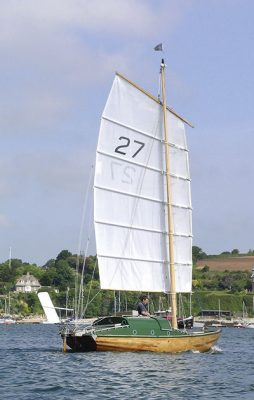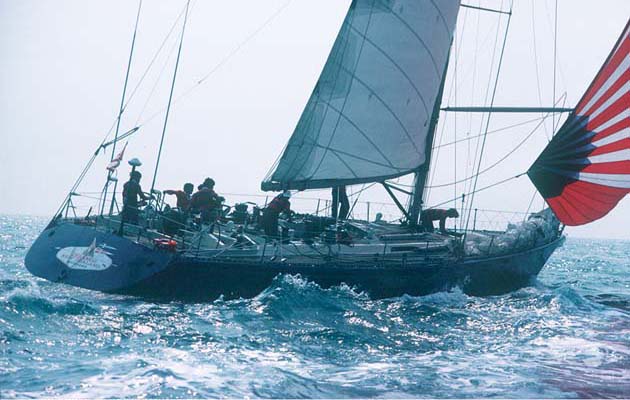
41. Jolie Brise
Built: 1913
Design: Alexandre Pâris/Paumelle
The 56ft gaff-rigged Jolie Brise was originally built to do a job of work. Although she appears to be a traditional pilot cutter, Jolie Brise was unusual for the time in being built to plans.
She was designed to cross oceans rapidly, and was the last boat to carry the Royal Mail under sail. However, she was too late to really show her worth as a pilot boat, and as steam replaced sail suffered some ignominious years as a tuna fishing boat.
Her fortunes changed after she was sold and refitted for racing, going on to take part in the inaugural Fastnet Race in 1925, which she won. She went on to win the 600-mile epic twice more, a record which remains unbeaten.

Photo: Paul Buttrose
42. Dorade
Built: 1929
Design: Sparkman & Stephens
Designer Olin Stephens was just 22 when the 52ft yawl Dorade was launched, built for his father Roderick Stephens as a great gamble on the success of a new business venture, a design house called Sparkman & Stephens.
The yacht, which he described as “a kind of awakening”, was both beautiful and radical from the outset. She was narrower in beam and lighter in construction than her contemporaries, partly due to the hull frames being steam-bent rather than sawn.
Stephens was confident that a slim hull with stability gained from a deep lead keel, would pay off. He was correct – although his calculations were thrown into question at Dorade’s launch, when the waterline stripe was three inches below the surface.
Any detractors were silenced by Dorade’s performance in the 1931 Transatlantic Race when she, the third smallest yacht in the fleet, reached the line more than two days ahead of the next. On corrected time, Dorade was almost four days faster. She went on to win the Fastnet Race of the same year by a wide margin.
The yacht became the first in a new generation of deep keeled, slim hulled, powerful racing yachts. Dorade was famously restored to once again race in the Transatlantic and Fastnet Races in 2015, scoring podium finishes in both offshores some 84 years after her first win. Sparkman & Stephens, of course, went on to become the most prolifically successful yacht design office of the 20th century.
43. Sundeer 68
Built: 1988
Design: Steve Dashew
An unsung hero of yacht design, Steve Dashew built small numbers of highly specialised cruising yachts.
Andrew Bishop of the World Cruising Club comments: “The powerful, balanced rigs are designed with sail handling for short-handed crews in mind, which, combined with their easily driven hull forms, make for consistently high speeds in a wide range of conditions. These boats were ahead of their time for modern fast cruising yachts.”
The range began with the 1978 Deerfoot, a 68-footer that featured the first swim platform, fore-and-aft watertight bulkheads, and an aft engine room.
They later launched the Sundeer range, which could comfortably cover 230 miles a day, a distance Dashew describes as “the magic number that keeps you safe and comfortable”.
44. USA 17
Built: 2007
Design: VPLP
The 33rd America’s Cup pitted a 34m trimaran against Alinghi’s giant catamaran. For BMW Oracle USA designers, VPLP, the project was a golden opportunity to rapidly accelerate multihull development, resulting in the famous wingsail.
Lauriot Prévost remembers: “In the original brief the boat had to be designed and built in ten months, and then there were lawyers and postponements, which meant instead of having ten months we had almost two and a half years.
“So that’s how the wingmast came onto the boat. Having worked on the platform, on the appendages, on everything else, we had to work on propulsion.” The original idea came from design director Mike Drummond.
“It was a crazy project because even at the final finish, when the second leg had been won by USA 17, we still had some modification projects that were on the table, changing the main hull and so on,” recalls Lauriot Prévost.
“It was really, really very intense. But I think the America’s Cup is exactly this: you can have the skills and money to achieve in two years what would take five or ten years on a usual project.”
45. Contessa 32
Built: 1970
Design: David Sadler / Jeremy Rogers
The gateway for many owners into yacht racing, the Contessa was a one-design, avoiding the vagaries and expense of IOR, and performed just as well as a family cruiser. Its seaworthy reputation was cemented during the 1979 Fastnet, when of the 58 boats in the smallest class, only one finished – the Contessa 32 Assent.
David Glenn explains: “The key to the the Contessa 32’s success was that the boats could perform two roles equally well. They could be raced as a one-design, which meant you didn’t have to adhere to the vagaries and expense of IOR, which was then the predominant racing rule, and perform just as well as a family cruising yacht.
“The David Sadler/Jeremy Rogers Contessa was designed in 1970 and more than 750 were built. At one time they had their own class in Cowes Week and they still race through an active class association. A good looking and very seaworthy yacht, chosen by many who wanted a go-anywhere, reliable and – for her day – fast boat.
“By today’s standards her accommodation is very limited. Nonetheless, a real winner in her time and many people aspired to owning one. They still do! She had that ‘must have’ ingredient.”

46. Aqua Quorum
Built: 1996
Design: Adrian Thompson
Ocean racer Dee Caffari nominates Pete Goss’s Aqua Quorum. “Most of my racing offshore is spent on boats with canting keels,” she explains, “but if we go back to 1991, Michel Desjoyeaux sailed the first distance offshore with a swing keel in a mini 6.50. This then led onto Pete Goss sailing Aqua Quorum, an open 50, in the 1996 Vendee Globe becoming the first to sail round the world with a canting keel.
“From this moment the world stopped questioning the canting keel concept. We agree that there are risks and as a result many races have adopted the one-design rule to try and reduce the risk factor, but no one has moved away from the extra stability and power this design can produce. It sure beats having 15 people on the rail to act as ballast!”

47. Jester
Built: 1953
Design: Blondie Haslar
With her unstayed Chinese ‘junk’ rig set on a modified 25ft Folkboat hull, Jester is unique. She was created by Herbert ‘Blondie’ Haslar, who believed that one did not need a racing machine in order to cross ocean miles.
He then sailed her in the 1960 race which he established for fellow singlehanded, Corinthian yachtsmen, from Plymouth to New York – at the time a revolutionary concept and the first solo ocean race.
It was won by Francis Chichester in Gipsy Moth II, with Jester second, and the race became the hugely successful OSTAR, held on a four-yearly cycle in various incarnations for many years since.
Jester competed in each one, until finally damaged by a rogue wave and abandoned in 1988. A replica Jester was built – and again raced in the OSTAR – in 1992.
Technically Jester was also very innovative, thanks to Haslar’s wind vane self-steering and rudimentary trim tab system, which he refined further over four Atlantic crossings – claiming to only take the tiller for an hour during the 1960 race. By 1970 over 600 units of Haslar’s Pendulum Servo Gear system had been fitted to yachts around the world.
Many other developments in short-handed racing were first tried during runnings of the OSTAR, such as the earliest weather routing in 1968 (it was subsequently banned).

48. Westerly Centaur
Built: 1968
Design: Jack Laurent Giles
“Designed in 1968 by Jack Laurent Giles, this was the people’s cruising boat, the ‘floating country cottage’,” comments David Glenn.
“She was a motor sailer really but she changed yachting by getting families afloat in their thousands and she is a still much loved second-hand yacht. Westerly built (I think) some 2,500. Those numbers speak for themselves.”

49. Istria
Built: 1912
Design: Camper & Nicholson
The 15-metre was the first yacht designed with a Marconi topmast, which was fitted with a track which meant the topsail could be hoisted from deck.
With 72 wins out of 81 starts for Istria, the gaff rig was rapidly demoted to the history books. Istria was also the first large yacht to be built using laminated materials to save weight.

Photo: Jean Jacques Bernard.
50. Ceramco
Built: 1980
Design: Farr
Peter Blake’s 68-footer with a bulb keel and flat stern was designed to surf around the world in the 1981-82 Whitbread, but she was dismasted on leg one. The crew set a jury rig and sailed 4,400 miles to rejoin the race and resume battle with Flyer.
Updated from an article that first appeared in the November 2016 issue of Yachting World magazine.



